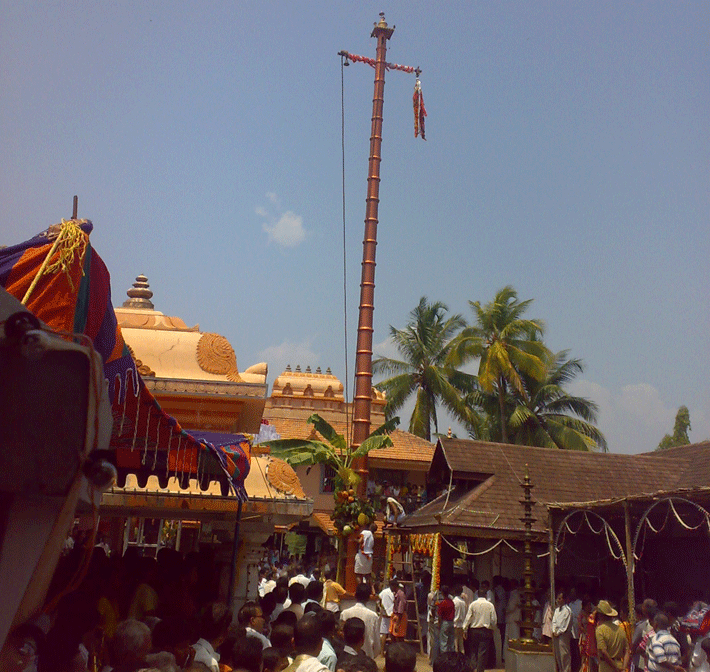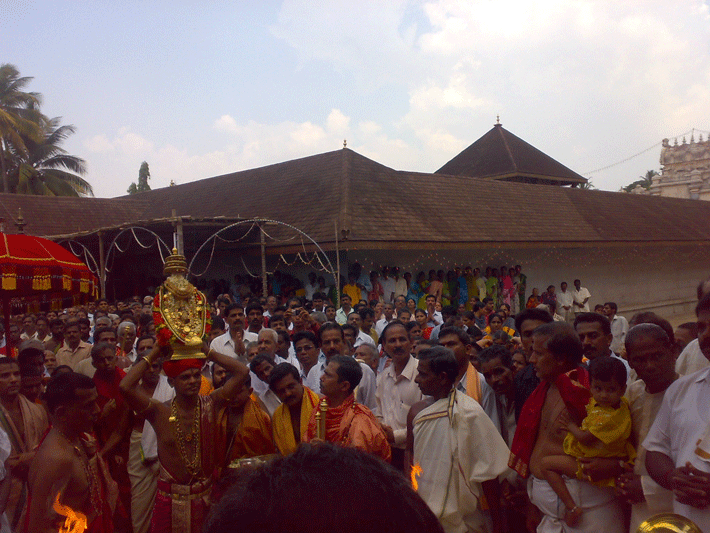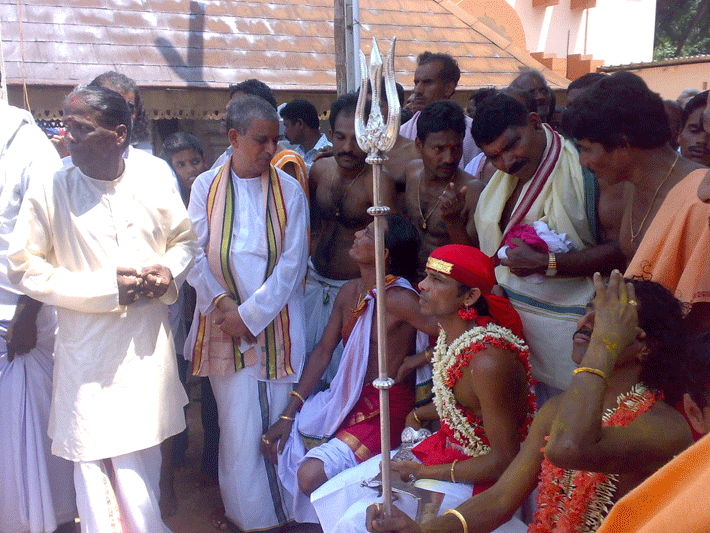Mainstream Hinduism
Our writers and philosophers have a tendency to brand the mainstream Temple culture, relating to the worship of Gods Shiva, Shakti, Vishnu etc as Vedic culture. That may not be the true picture of facts. Many of the core concepts of the Temple culture are pre-Vedic in origin and some of the concepts have obviously been added in the post Vedic period. And if we are referring to the word ‘Hinduism’ to the set of beliefs and practices grown and practiced in this country then the word ‘Hinduism’ should rightfully include Spirit worship, Jainism and Buddhism along with the mainstream Temple culture. Therefore this blog has preferred to use the distinguishing word ‘mainstream Hinduism’ to represent what other authors generally refer to as Vedic culture.

An image of flag-hoisting ceremony, Bappanad Durga temple,Mulky.
Rituals of transition of cults
The temples of Karavali evince a number of traditional rituals whose meanings have been obscure with passage of time. Have you ever analysed the nature and meaning of some of these rituals? I would like to draw your attention to a few rituals in the temples of Tulunadu/Karavali that reminds the conflicts developed during the shift of faiths.
A temple flag hoisting ritual
Flag hoisting is a ceremony that marks the beginning of festive activities (usually a week long) that culminate in the car festival of the temple. The occasion is known as ‘Kodi Eruni’ (=flag hoisting).In front of the temples there is a tall wooden flag post, usually covered with copper or brass sheets. The ceremony is centered on hoisting a flag (‘koDi’) representing a ‘Vetala’ or ‘Garuda’ (that looks like an image of a naked man) on the ornate flag-post called ‘kodimara’.
The flag hoisting ceremony of the Bappanad (pronounced: bappa naaD or naaDu.) Durga Parameswari temple, Mulki, located about 30 kms north of Mangalore city, recently occurred on March 20, 2008. The Bappanad temple is known to have been built by a Muslim sea-faring merchant called Bappa.

A Procession of Utsava-murthy at Bappanad after the flag-hoisting event.
Symbolic conflict of cults
An interesting sub-event of is celebrated on the occasion at Bappanad temple. This is symbolic of historical confrontation of the Spirit and Kapalika /Natha cults with Shakti cult. A group of people led by two persons dressed in the costumes of a human medium of a Spirit (darshana paatri of Bhoota) with a traditional curved sword (kaDsale) in the hand and a trident holding Kapalika/Natha arrive at the southwestern gate of the temple. The two characters are shivering in the typical style of Spirit trances. They watch the flag-hoisting proceedings with rapt attention and while the flag is being hoisted suddenly turn their bodies in the opposite direction of flag-post as if they do not wish to see the hoisting ceremony. They revert back to normal position after completion of hoisting event. The darshana patri of the Goddess who carries the utsava murthy on his head and walks around the temple in ceremonial procession approaches the two representatives of the Spirit and Natha cults. The Spirit-Natha duo confronts the ‘Goddess’-bearer as if questioning or complaining rebelliously that their rightful place and honour have been confiscated by the Goddess! (Eyewitnesses report that earlier days in the history scolding and foul languages were used).These Spirit-Natha duo are selected from the Malayalee Thiya(formerly Buddhists)community residing at nearby Sasihitlu village.
This enactment forms an integral part of the annual flag-hoisting ceremony at Bappanad. Similar events can be witnessed in Durga temples in the Karavali. The ‘Bali’ ceremony in Durga temples (like in Mundkur) also displays similar symbolic rebellious ‘confrontation’ between the Goddess-bearer and the Spirit medium.

The spirit-medium (in red headgear)and Kapalika/Natha (with trident)at Bappanad.
Throes of transition of cults
The origin and the socio-psychological interpretation of the above ritual are candid and clear. Infact, the cited celebrations are the representative vestiges of the historical confrontation between the rival cults. The native people worshipped Spirits since early historical days. The basic psychology of faith on the Supernatural works out in the same way irrespective of whether one worships a Spirit, a God or Goddess. When a new system of faith, another cult, was thrust upon them they were confused. While the common man was confused, the protagonists of the two rival cults were at loggerheads. At that time, the common man had to be convinced that cult 2 is superior to cult1.The new temples at that time in the history were architecturally and aesthetically superior, patronized by kings and chieftains and were more organized with ornamental and floral decorations, music, lights and rituals compared to that of the older cults.
OTHER STATIC EVIDENCES OF TRANSITION
Apart from the rituals of the sort described above there are a number of static evidences or relics of evidences in and around the Temples of Tulunadu that point towards the effect of transition from the Spirit cult to the Temple culture.A few of them are cited below:
Kshetrapala
Most of the temples have a ‘khetrapala’ (=protector of the premises) with a small shrine analogous to the modern security guard or chief with a cabin. The kshetrapala is mostly a vestige of Spirit formerly worshipped in the area.In the Bappanad temple the Kshetrapala Spirit was the Panjurli.
Again the psychology of the nomination of ‘Kshetrapala’ is candid. A Spirit worshipped by the natives formerly was not destroyed (as it would raise a rebellion) but was absorbed into the temple culture and psychologically reduced to the post of a security chief of the newly built temple!
In many temples initially the shrine of Kshetrapala was quite large like regular Spirit temples (Sana). With periodic modernization of temples (known as Brahmakalasha) the size of shrine of Kshetrapala were reduced consistently. Some of the lesser known Kshetrapala have been removed altogether during ceremonial renovations.
Vetala
The Vetala (Betala) raised as a flag in the temples is also a form of Spirit worshipped formerly in parts of northern Karnataka, Maharastra and Andhra. Similar to the concept of Kshetrapala, the ancient cult of Vetala worship was absorbed into the temple culture and was made into a flag.
Brahma, the Jain Yaksha
The concept of absorption of Spirit cult as Kshetrapala is not exclusive to mainstream Hindu temples. The Jain temples have an imposing rock-pillar called mana-sthambha in the front. Many of these rock pillars have Brahma as a Kshetrapala or Yaksha. The Brahma on the mana-sthambha is not the four headed creator popular in the post Vedic traditions, but the Bermer, the horse mounted Spirit deity traditionally worshipped by the Tulu communities.
®



No comments:
Post a Comment